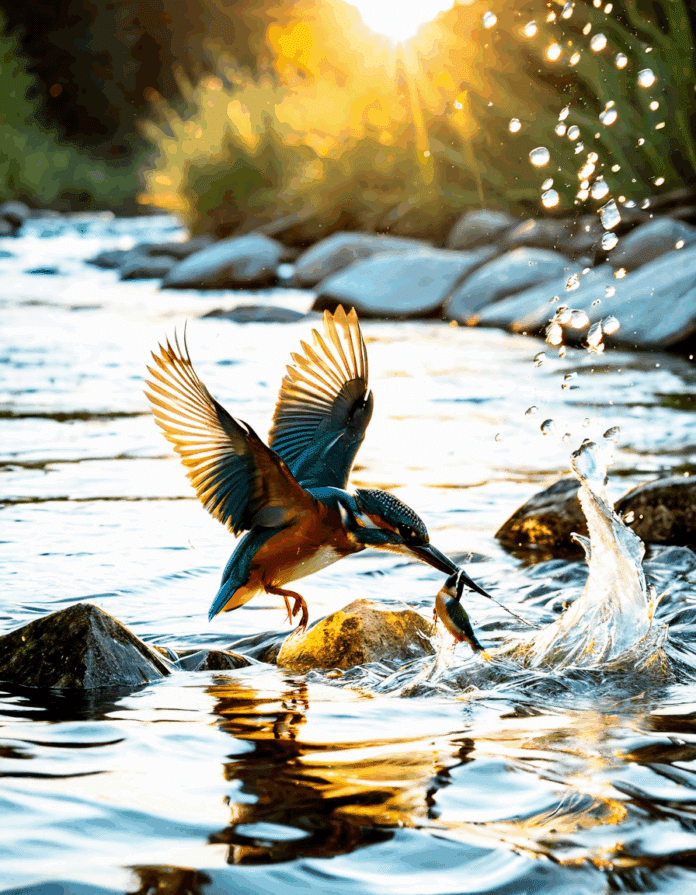Kingfishers are magnificent birds that introduce us to a dazzling display of color and skill in the sky. With their vibrant feathers and incredible diving abilities, these avian wonders have fascinated bird enthusiasts and casual observers alike. They thrive on every continent except Antarctica, serving as symbols of beauty and indicators of thriving aquatic ecosystems. Their charming adaptations, along with intriguing behavioral traits, invite us into their enchanting world, where they reign as master hunters and essential ecological players.

The Fascinating World of Kingfishers
Diving into the life of the kingfisher reveals a rich tapestry of natural wonders. These birds are not just pretty faces; they possess unparalleled hunting skills that make them effective predators. Their keen eyesight helps them spot prey from high above, and their strikingly colorful plumage often reflects their habitats. Kingfishers typically reside near water bodies, where they can hunt fish and invertebrates.
Moreover, the mere presence of kingfishers signifies a balanced ecosystem. Their diets rely heavily on aquatic organisms, meaning that changes in fish populations can directly impact their survival. As indicators of water quality, their well-being often reflects the health of lakes, rivers, and streams. These factors combine to make kingfishers not just a delight to watch but also vital to environmental scientists and conservationists.
The world of kingfishers is filled with a diverse ‘band of brothers.’ Each species boasts its own fascinating traits that adapt to its surroundings. Let’s explore seven enchanting varieties that bring the planet’s waterways to life.

Top 7 Enchanting Species of Kingfishers
Easily spotted across Europe and Asia, this species dazzles with its blue and orange feathers. The Common Kingfisher often perches on branches overhanging water before diving to catch small fish, showcasing its remarkable skill.
Standing as the tallest kingfisher at about 17 inches, the Giant Kingfisher calls sub-Saharan Africa its home. It boasts a loud call that echoes through its forested routes, along with a fluffy crest that adds to its distinctive look.
In North America, this species stands out with its mohawk-like crest and notable diving tactics. The Belted Kingfisher is often seen hovering before diving, plunging with accuracy to catch its lunch.
Renowned for its remarkable agility, the Pied Kingfisher holds court over Africa and parts of Asia. Its striking black and white plumage pairs impressively with its hovering capabilities, endearing it to birdwatchers.
Adorned in shocking azure, this species roams the rivers and estuaries of Australia and New Guinea. Its compact size and swift movements make every sighting an exhilarating experience.
Found along the riverbanks of South Asia, this petite bird dazzles with its blue back and distinctive white throat, fitting seamlessly into its picturesque habitat.
This elusive beauty thrives in Southeast Asia’s dense forests. With its vibrant orange-brown hues, the Rufous-backed Kingfisher remains a symbol of jungle mystery, captivating those lucky enough to glimpse it.
Behavioral Patterns: Masterful Hunters of the Sky
Kingfishers operate with unique hunting styles that reflect their adaptability and intelligence. For example, the Belted Kingfisher often prefers solitude during breeding but switches gears to form small social flocks during migration. This fascinating duality illustrates the complexities of their social structures.
In contrast, the Common Kingfisher takes a cooperative approach while hunting. Often seen flying in pairs, they work together to catch prey more efficiently, demonstrating teamwork that’s rare among birds. Their social dynamics reveal intricate instincts that enhance survival.
Additionally, species such as the Pied Kingfisher exhibit remarkable techniques by hovering above the water before taking the plunge. This mastery of aerial flair emphasizes their evolutionary advantage, equipping them with the skills needed to thrive in their environments.
The Ecological Significance of Kingfishers
Kingfishers serve crucial ecological functions, underscoring their importance in maintaining balanced ecosystems. By preying on fish and invertebrates, they help regulate populations within aquatic environments. This balance is essential for preserving biodiversity and ensuring healthy waterways.
Moreover, kingfishers can provide valuable insights into environmental health. Their sensitivity to pollution and habitat changes positions them as key indicators of water quality. Scientists and conservationists rely on the presence of these birds to gauge the biological condition of aquatic systems and inform their conservation strategies.
In essence, kingfishers aren’t just beautiful birds; they are integral components of their ecosystems. Their actions and survival impact the environments they inhabit, which in turn affects broader ecological processes.
Conservation Status and Threats Facing Kingfishers
Despite their resilience, many kingfisher species face increased threats from human activity, habitat loss, and pollution. The International Union for Conservation of Nature has classified the Rufous-backed Kingfisher as vulnerable due to the rampant deforestation affecting its habitat.
Habitat destruction from urban development and agriculture has far-reaching implications for the survival of these remarkable birds. Water pollution from industrial runoff and plastic waste presents additional dangers. Such environmental challenges highlight the urgent need for focused conservation efforts.
Preserving kingfishers also means fostering a healthy aquatic environment. By engaging communities in conservation initiatives and promoting sustainable practices, we can safeguard future generations of these enchanting birds and the ecosystems they inhabit.
Celebrating Kingfishers Through Culture and Art
Kingfishers hold a fascinating place in cultural folklore and artistic representation. Across different societies, these birds are often viewed as symbols of fortune, peace, and prosperity. Their vivid colors and graceful flights have inspired countless artists, from early ornithologists like John James Audubon to modern-day photographers who capture their spectacular beauty.
Art inspired by kingfishers extends beyond the canvas, influencing architecture, literature, and fashion. For example, Cato Fashions has drawn on nature’s beauty, weaving kingfisher motifs into their collections. This artistic interpretation helps keep the allure of kingfishers alive in contemporary culture.
Additionally, stories revolving around kingfishers are shared across generations, influencing how societies view nature and wildlife. The fascination with these birds continues to grow, reminding us of our interconnectedness with the natural world.
The Future of Kingfishers in Our Changing World
Understanding the roles that kingfishers play in our ecosystems is vital as we face global environmental challenges. By advocating for responsible water management and environmental conservation, we can create a future where kingfishers thrive alongside other species. As urbanization spreads and pollution escalates, collective action is crucial to protect these feathered wonders.
Public awareness of kingfishers’ importance encourages community involvement in conservation initiatives. By showcasing their vibrant appeal, we inspire others to join the movement, fostering appreciation for biodiversity and nature’s beauty. Just as getting Preapproved For a mortgage represents a step toward financial security, conservation efforts pave the way toward ecological health.
In conclusion, through the lens of science, culture, and dedication to conservation, we can appreciate the majesty of kingfishers as they dive into their enchanting world. Their vivid presence enriches global biodiversity and beckons us to safeguard the delicate ecosystems they inhabit. Let’s cherish these remarkable aviators and ensure their survival for future generations, ensuring that every dive into their world remains a breathtaking spectacle.
Discovering the Kingfisher: Nature’s Dazzling Diver
A Splash of Color and Precision
The kingfisher is a bird that’s often admired for its brilliant plumage and incredible diving skills. These striking birds sport vibrant hues, including blues and oranges, which can easily brighten up any view. They attract attention not just for their colors but also for their remarkable hunting technique. Did you know that a kingfisher can dive at speeds of up to 40 miles per hour? That’s quicker than a lot of professional athletes, making it top-notch in its game—akin to the thrilling action seen in the Cowboys Vs Commanders games!
Fascinating Habits and Habitat
What’s really interesting is how kingfishers hunt. They perch silently, scanning the water for movement, and then, with a swift plunge, they snatch up fish with precision. This practice reminds one of finding a job where you have to be spot on—kind of like those searching for baltimore city Jobs. Their ability to dive and emerge with a catch is a source of fascination for birdwatchers and nature lovers alike. Not to mention, their nests can often be found in sandy banks near rivers—a strategic choice that protects them from predators.
Cultural Connections and Myths
Throughout history, kingfishers have inspired various tales and traditions. Many cultures view them as symbols of peace and prosperity. Interestingly, there’s a legend that says the kingfisher can control the weather—a concept that may sound a bit like the strange tales surrounding the black knight satellite. Moreover, their vibrant presence has earned them roles in various media, and they’ve appeared in everything from traditional folklore to modern films, much like the excitement around the cast Of back in action films.
So, the next time you spot a kingfisher flitting over a river, take a moment to appreciate not just its beauty but the deep connection it shares with different cultures around the globe—just as we connect through shared interests like Gretchen Wilson’s music or even FA Cup Fixtures. These charming birds remind us that nature is truly a wonder, brimming with hidden gems and stories waiting to be explored.




